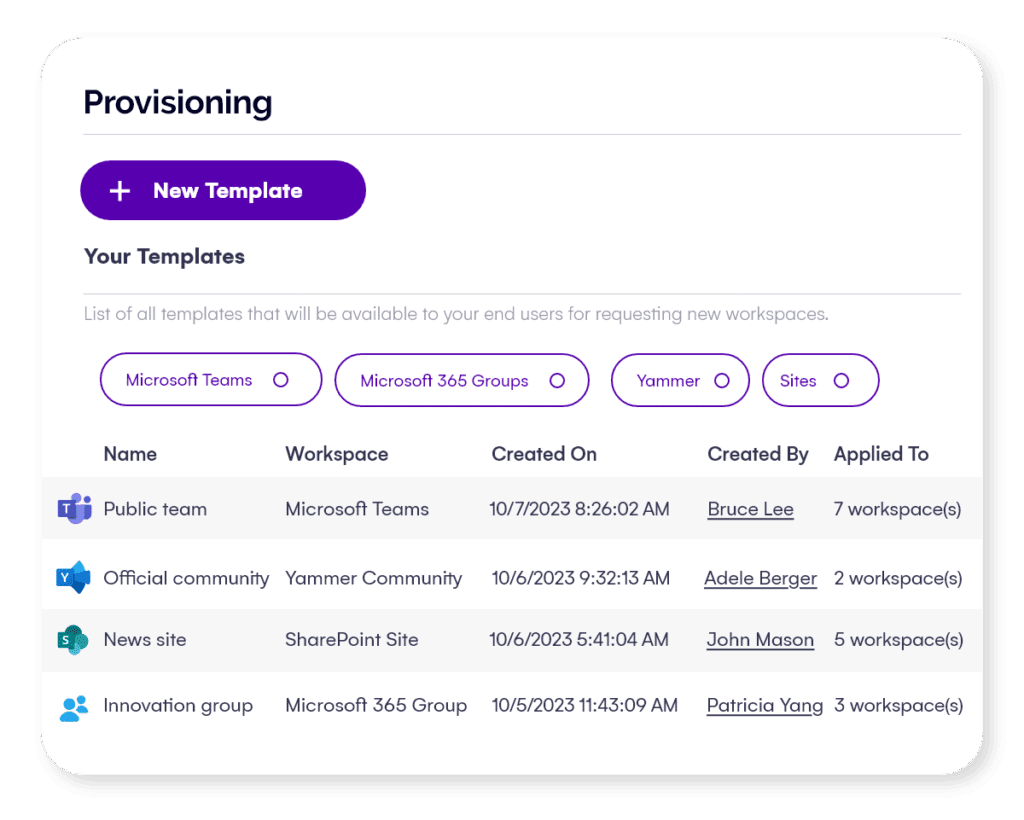Automated provisioning in Microsoft 365
Table of contents
Automated provisioning is really important when we talk about Microsoft 365 administration. You see, provisioning in Microsoft 365 has always been a balancing act. On one hand, organizations want to empower employees to spin up new Teams, SharePoint sites, or Groups quickly to keep projects moving.
On the other hand, IT must ensure consistency, security, and compliance at scale. Commonly, provisioning entails repetitive manual work for IT: creating workspaces, applying security settings, adding members, and configuring tools. That process doesn’t scale well, and it leaves plenty of room for mistakes. Enter automated provisioning.
In this blog post, we’ll explore the basics of what automated provisioning is, why it matters, how it works in Microsoft 365, and other provisioning terms that are important when it comes to managing the entire lifecycle of collaboration.
What is automated user provisioning?
Automated user provisioning is the process of creating and managing user accounts, access rights, and collaboration spaces automatically — based on predefined rules and templates.
For example, when a new employee joins the marketing team, automation could:
- Create their Microsoft 365 account.
- Assign them a license.
- Add them to the appropriate Teams and SharePoint sites.
- Apply security settings based on company policy.
Instead of IT spending hours configuring access manually, automated provisioning ensures the user is ready to go on day one, with everything they need to collaborate securely.
Why automated provisioning matters?
Automated provisioning brings benefits that go far beyond saving time:
- Consistency and standardization
Every new workspace follows the same structure—channels, libraries, permissions, and naming conventions. That means fewer duplicates, less confusion, and better findability. - Security and compliance
Automation ensures permissions are applied correctly from the start, reducing the risks of over-provisioning or unauthorized access. Plus, automated audit logs make compliance reporting easier. - Efficiency and scalability
As organizations grow, automation scales provisioning without overwhelming IT teams. Whether it’s ten new workspaces or a thousand, the process stays reliable. - Improved employee experience
New hires and project teams get access to the right tools faster, which means less waiting on IT and more time focusing on work that matters.
Automated provisioning tools in Microsoft 365
Microsoft offers several automated provisioning tools out of the box:
- Teams templates: Prebuilt or custom templates that configure channels and apps.
- SharePoint templates: Predefined structures for lists, libraries, branding, and navigation.
- Naming policies and blocked words: Governance features to standardize workspace names.
- Group creation restrictions: Controls to determine who can create new workspaces.
While helpful, these features often cover only a part of the provisioning puzzle. For example, Teams templates can’t enforce SharePoint settings, and SharePoint templates don’t configure Teams. This leaves many organizations looking for more robust solutions—either custom-built workflows using Power Automate, Logic Apps, and PnP PowerShell, or dedicated third-party tools.

Beyond provisioning: the importance of automated deprovisioning
Provisioning is only half the story. Without a strategy for automated deprovisioning, organizations risk accumulating inactive, duplicate, or “ownerless” workspaces that clutter the tenant and create compliance risks.
Automated deprovisioning helps by:
- Archiving or deleting inactive workspaces based on policies.
- Reclaiming unused licenses.
- Revoking access when employees change roles or leave the company.
- Triggering recertification workflows so owners can confirm whether a workspace is still needed.
By pairing provisioning with automated cleanup, organizations keep their Microsoft 365 environment both secure and sustainable.
Building a mature automated provisioning system
Organizations usually progress through a few stages of provisioning maturity:
- Manual provisioning – IT creates everything by hand.
- Basic automation – Using Teams and SharePoint templates for faster setup.
- Custom automation – Adding request forms, approval workflows, templates, and reporting with Power Automate or Azure Logic Apps.
- Enterprise-grade automation – Centralized provisioning engines that enforce governance across Teams, SharePoint, Groups, and beyond, often with lifecycle management and self-service portals.
The right level of automation depends on organizational size, governance requirements, and available IT resources.
Stop struggling with Microsoft 365 provisioning
As I mentioned previously, automated provisioning benefits go far beyond just time saving. Automated provisioning is a cornerstone of sustainable Microsoft 365 governance that enables organizations to give employees the freedom to collaborate while ensuring IT retains full control and compliance.
Whether you rely on Microsoft’s built-in tools, are looking to build your own system, or adopt a dedicated provisioning solution, the message is clear: automation is the only way to keep Microsoft 365 environments secure and under control. If you want to learn more about Microsoft 365 provisioning and improve it, check out our Governance handbook which has useful provisioning advice for Microsoft beginners and pros.


